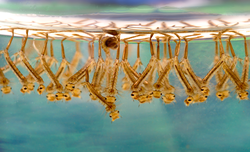Mosquitofish
The western mosquitofish (Gambusia affinis) is a North American freshwater poeciliid fish in the Poeciliidae family. It is from the southern and midwestern United States and east coast of Mexico.[1][2] Human beings brought it to many other places, for example Hawaii, Puerto Rico, and Australia. It has caused problems as an invasive species. Some scientists say that the western mosquitofish has had the largest effect on the environment of any fish in the family Poeciliidae.[2][3]
| Mosquitofish | |
|---|---|

| |
| Female | |

| |
| Male | |
| Conservation status | |
| Scientific classification | |
| Kingdom: | Animalia |
| Phylum: | Chordata |
| Class: | Actinopterygii |
| Order: | Cyprinodontiformes |
| Family: | Poeciliidae |
| Genus: | Gambusia |
| Species: | G. affinis
|
| Binomial name | |
| Gambusia affinis (S. F. Baird & Girard, 1853)
| |
| Synonyms | |
| |
Size
The adult male western mosquitofish grows to 4 cm (1.6 in) and the female to 7 cm (2.8 in).[4] It has a round tail fin.[3] It eats algae, insects, and other invertebrates. It can eat more than its own body weight every day.[2] It can live in water that is twice as salty as seawater. It can live in water as hot as 43°C.[3] The western mosquitofish usually has 60 eggs at a time, but it can have as many as 300 at a time. The eggs stay inside the female's body until they hatch.[3]
Invasive species
In the early 20th century, human beings caught western mosquitofish and took them to other places. They did this because they thought the western mosquitofish would eat mosquitoes and their young. This did not work. Sometimes there were more mosquitoes than before: The western mosquitofish killed other fish that were eating mosquitoes. It did this by either eating the other fish, killing them without eating them, or eating so much of the food that the other fish died. The western mosquitofish sometimes killed fish that were better at killing mosquitoes than it was. It also ate some of the insects that had been eating the mosquitoes and mosquito young. It also ate zooplankton, which left more food for the mosquito young to eat themselves.[2]
The western mosquitofish can kill larger fish by biting their fins and eating their eggs and babies. It kills and eats smaller fish. It kills frogs by eating their eggs and tadpoles.[2] After people put western mosquitofish in a body of water, there may be an algal bloom because the western mosquitofish kills all the fish that usually eat algae.[2] The western mosquitofish is one reason why many other species are endangered. Some of the important ones are the Gila topminnow (Poeciliopsis occidentalis),[5] and the damselfly in Hawaii.[2]
Name
The western mosquitofish G. affinis and eastern mosquitofish G. holbrooki used to both be called G. affinis because people thought they were the same species. They are not. According to the IUCN Global Invasive Species Database, most records in Australia that say "G. affinis" really mean G. holbrooki.[3]
Mosquitofish Media
Larvae of Culex Mosquitoes. As seen on the picture, larvae make dense groups in standing water. A shift in the feeding behavior of those mosquitoes helps explain the rising incidence of West Nile virus in North America. It appears that the darker structure at the top center of the image is one pupa.
References
- ↑ 1.0 1.1 NatureServe (2019). "Gambusia affinis". IUCN Red List of Threatened Species. IUCN. 2019: e.T166562A58317114. doi:10.2305/IUCN.UK.2019-2.RLTS.T166562A58317114.en.
- ↑ 2.0 2.1 2.2 2.3 2.4 2.5 2.6 Nico, L.G.; Fuller, P.; Jacobs, G.; Cannister, M.; Larson, J.; Fusaro, A.; Makled, T.H.; Neilson, M.E. (January 25, 2016). "Gambusia affinis (Baird and Girard, 1853): U.S. Geological Survey, Nonindigenous Aquatic Species Database". Gainesville, FL: United States Geological Survey. Retrieved June 28, 2020.
- ↑ 3.0 3.1 3.2 3.3 3.4 "Gambusia affinis". IUCN Global Invasive Species Database. June 21, 2010. Retrieved June 28, 2020.
- ↑ "1Western Mosquitofish (Gambusia affinis): Ecological Risk Screening Summary" (PDF). United States Fish and Wildlife Service. November 15, 2017. Archived from the original (PDF) on November 12, 2020. Retrieved June 29, 2020.
- ↑ Environmental Conservation Online System. "Gila topminnow (incl. Yaqui) (Poeciliopsis occidentalis)". U.S. Fish and Wildlife Service. Retrieved December 15, 2021.


